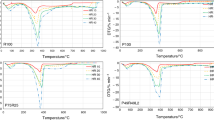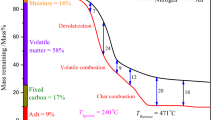Abstract
The combustion behaviors of lignite/eucalyptus bark under oxy-fuel condition were assessed based on a thermal analysis technique. The influences of oxygen concentration, heating rates and blending ratios on oxy-fuel combustion performances were revealed, which were compared with those in air. The ignition and comprehensive combustion indices increased with increasing oxygen contents during oxy-fuel combustion. At three heating rates of 10, 15 and 20 K min−1, the average comprehensive performance indices of lignite/eucalyptus bark in 40 %O2/60 %CO2 were about 5–7 times more than those in air. The average comprehensive performance indices of lignite/eucalyptus bark in air were about 2–3 times more than those in O2/CO2 atmosphere at analogous oxygen content. At heating rate of 20 K min−1, the ignition and comprehensive performance indices of lignite/eucalyptus bark in 25 %O2/75 %CO2 were very near to those in air. The combustion kinetics were also evaluated in conjunction with volatile matter and fixed carbon burning periods using Doyle’s and Coats–Redfern’s models. The oxy-fuel combustion kinetics of lignite/eucalyptus bark at oxygen content of 30 % was similar to that in air. There were more significant synergistic effects between lignite and eucalyptus bark during their co-combustion in air and O2/CO2 with oxygen contents of 25 and 30 %.




Similar content being viewed by others
Abbreviations
- a :
-
Conversion degree
- A :
-
The pre-exponential (s−1)
- D :
-
Combustion index
- E a :
-
Apparent activation energy (J mol−1)
- R :
-
The universal gas constant (J mol−1 K−1)
- T :
-
Temperature (K/°C)
- β :
-
Heating rate (K min−1)
- b:
-
Burnout
- c:
-
Comprehensive performance
- i:
-
Ignition
- m:
-
Mean
- max:
-
Maximum
- p:
-
Peak
References
Sun B, Yu J, Tahmasebi A, Han Y. An experimental study on binderless briquetting of Chinese lignite: effects of briquetting conditions. Fuel Process Technol. 2014;124:243–8. doi:10.1016/j.fuproc.2014.03.013.
Lee D-W, Bae J-S, Lee Y-J, Park S-J, Hong J-C, Lee B-H, et al. Two-in-one fuel combining sugar cane with low rank coal and its CO2 reduction effects in pulverized-coal power plants. Environ Sci Technol. 2013;47(3):1704–10. doi:10.1021/es303341j.
Darvell LI, Jones JM, Gudka B, Baxter XC, Saddawi A, Williams A, et al. Combustion properties of some power station biomass fuels. Fuel. 2010;89(10):2881–90. doi:10.1016/j.fuel.2010.03.003.
Pang CH, Hewakandamby B, Wu T, Lester E. An automated ash fusion test for characterisation of the behaviour of ashes from biomass and coal at elevated temperatures. Fuel. 2013;103:454–66.
Sarkar P, Sahu SG, Chakraborty N, Adak AK. Studies on potential utilization of rice husk char in blend with lignite for cocombustion application. J Therm Anal Calorim. 2014;115(2):1573–81. doi:10.1007/s10973-013-3499-z.
Sahu SG, Chakraborty N, Sarkar P. Coal–biomass co-combustion: an overview. Renew Sustain Energy Rev. 2014;39:575–86. doi:10.1016/j.rser.2014.07.106.
Kocabas-Atakli ZO, Okyay-Oner F, Yurum Y. Combustion characteristics of Turkish hazelnut shell biomass, lignite coal, and their respective blends via thermogravimetric analysis. J Therm Anal Calorim. 2015;119(3):1723–9. doi:10.1007/s10973-014-4348-4.
Varol M, Atimtay AT, Bay B, Olgun H. Investigation of co-combustion characteristics of low quality lignite coals and biomass with thermogravimetric analysis. Thermochim Acta. 2010;510(1–2):195–201.
Moon C, Sung Y, Ahn S, Kim T, Choi G, Kim D. Effect of blending ratio on combustion performance in blends of biomass and coals of different ranks. Exp Thermal Fluid Sci. 2013;47:232–40. doi:10.1016/j.expthermflusci.2013.01.019.
Wang G, Zhang J, Shao J, Ren S. Characterisation and model fitting kinetic analysis of coal/biomass co-combustion. Thermochim Acta. 2014;591:68–74. doi:10.1016/j.tca.2014.07.019.
Bejarano PA, Levendis YA. Single-coal-particle combustion in O2/N2 and O2/CO2 environments. Combust Flame. 2008;153(1–2):270–87. doi:10.1016/j.combustflame.2007.10.022.
Shaddix CR, Molina A. Particle imaging of ignition and devolatilization of pulverized coal during oxy-fuel combustion. Proc Combust Inst. 2009;32(2):2091–8. doi:10.1016/j.proci.2008.06.157.
Liu H, Zailani R, Gibbs BM. Comparisons of pulverized coal combustion in air and in mixtures of O2/CO2. Fuel. 2005;84(7–8):833–40. doi:10.1016/j.fuel.2004.11.018.
Molina A, Shaddix CR. Ignition and devolatilization of pulverized bituminous coal particles during oxygen/carbon dioxide coal combustion. Proc Combust Inst. 2007;31(2):1905–12. doi:10.1016/j.proci.2006.08.102.
Riaza J, Álvarez L, Gil MV, Pevida C, Pis JJ, Rubiera F. Ignition and NO emissions of coal and biomass blends under different oxy-fuel atmospheres. Energy Procedia. 2013;37:1405–12. doi:10.1016/j.egypro.2013.06.016.
Cahyadi, Surjosatyo A, Nugroho YS. Predicting behavior of coal ignition in oxy-fuel combustion. Energy Procedia. 2013;37:1423–34. doi:10.1016/j.egypro.2013.06.018.
Arias B, Pevida C, Rubiera F, Pis JJ. Effect of biomass blending on coal ignition and burnout during oxy-fuel combustion. Fuel. 2008;87(12):2753–9. doi:10.1016/j.fuel.2008.01.020.
Liu H, Zailani R, Gibbs BM. Pulverized coal combustion in air and in O2/CO2 mixtures with NOx recycle. Fuel. 2005;84(16):2109–15. doi:10.1016/j.fuel.2005.04.028.
Farrow TS, Sun C, Snape CE. Impact of biomass char on coal char burn-out under air and oxy-fuel conditions. Fuel. 2013;114:128–34. doi:10.1016/j.fuel.2012.07.073.
Liu X, Chen M, Yu D. Oxygen enriched co-combustion characteristics of herbaceous biomass and bituminous coal. Thermochim Acta. 2013;569:17–24. doi:10.1016/j.tca.2013.06.037.
Irfan MF, Arami-Niya A, Chakrabarti MH, Wan Daud WMA, Usman MR. Kinetics of gasification of coal, biomass and their blends in air (N2/O2) and different oxy-fuel (O2/CO2) atmospheres. Energy. 2012;37(1):665–72. doi:10.1016/j.energy.2011.10.032.
Zhang Y, Zhang L, Duan F, Jiang X, Sun X, Chyang C. Co-combustion characteristics of sewage sludge with different rank bituminous coals under the O-2/CO2 atmosphere. J Therm Anal Calorim. 2015;121(2):729–36. doi:10.1007/s10973-015-4582-4.
Liu X, Chen M, Wei Y. Kinetics based on two-stage scheme for co-combustion of herbaceous biomass and bituminous coal. Fuel. 2015;143:577–85. doi:10.1016/j.fuel.2014.11.085.
Zhang K, Zhang K, Cao Y, Pan W. Co-combustion characteristics and blending optimization of tobacco stem and high-sulfur bituminous coal based on thermogravimetric and mass spectrometry analyses. Bioresour Technol. 2013;131:325–32. doi:10.1016/j.biortech.2012.12.163.
Ding L, Zhang Y, Wang Z, Huang J, Fang Y. Interaction and its induced inhibiting or synergistic effects during co-gasification of coal char and biomass char. Bioresour Technol. 2014;173:11–20. doi:10.1016/j.biortech.2014.09.007.
Yi B, Zhang L, Mao Z, Huang F, Zheng C. Effect of the particle size on combustion characteristics of pulverized coal in an O2/CO2 atmosphere. Fuel Process Technol. 2014;128:17–27. doi:10.1016/j.fuproc.2014.06.025.
Yuzbasi NS, Selçuk N. Air and oxy-fuel combustion behaviour of petcoke/lignite blends. Fuel. 2012;92(1):137–44. doi:10.1016/j.fuel.2011.08.026.
Li Q, Zhao C, Chen X, Wu W, Li Y. Comparison of pulverized coal combustion in air and in O2/CO2 mixtures by thermo-gravimetric analysis. J Anal Appl Pyrol. 2009;85(1–2):521–8. doi:10.1016/j.jaap.2008.10.018.
Acknowledgements
This work was supported by the National Natural Science Foundation of China under No. 51376017 and the Fundamental Research Funds of China for the Central Universities under No. 2015YJS133.
Author information
Authors and Affiliations
Corresponding author
Rights and permissions
About this article
Cite this article
Wei, Y., Chen, M., Niu, S. et al. Evaluation on oxy-fuel co-combustion behavior of Chinese lignite and eucalyptus bark. J Therm Anal Calorim 123, 1667–1684 (2016). https://doi.org/10.1007/s10973-015-5050-x
Received:
Accepted:
Published:
Issue Date:
DOI: https://doi.org/10.1007/s10973-015-5050-x




